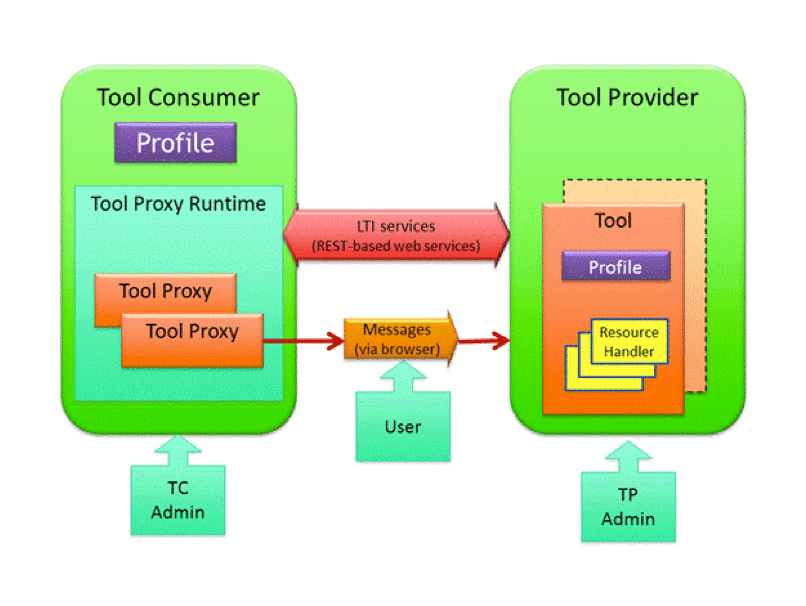Helping Educators With Seamless Education Delivery
Transitioning to a digital learning ecosystem has unlocked abundant innovative opportunities for students, educational institutions, and educational publishers. The traditional model of learning has its own set of benefits and challenges. However, blending it with digital tools has enabled access to huge volumes of data that can be used to make data-driven decisions for innovation in teaching methods, curriculum design, and learning experiences. One of the most important legs of a digital learning ecosystem is 1EdTech's Learning Tools Interoperability or LTI standard. It works as a single framework that integrates any Learning Management System (LMS) with any learning application. This empowers educators and students to quickly yet safely navigate the digital ecosystem and ease education delivery.
LTI: A Single Platform To Ease Innovation
Enabling interoperability could have proven to be an almost insurmountable challenge had it not been for the innovative solutions offered by digital learning platforms. Such a platform offers three key functions to ensure a seamless digital ecosystem for education:
- Content and activity management
A digital learning platform can allow for student-content interactions through creating and delivering lessons, additional learning resources, multimedia assets, and assessments. It ensures quick creation, deployment, grading, and tracking of assessments. Further, educators are empowered to offer individualized, data-driven support to students for enhanced academic outcomes. - Engagement management
Student-faculty and student-student interactions are enabled with the help of collaboration tools, such as message or discussion boards, chats, and video conferencing. For instance, single sign-on (SSO) is enabled via integration with third-party systems, such as Clever. Plus, custom integrations are flexible. - Learning management
The digital learning platform should support the management of rosters, grades, analytics, and outcomes reporting. Publishers can create curriculum-aligned assignments, while educators can save a lot of time in deploying and grading these assignments. Students have the facility to complete assignments asynchronously and receive personalized feedback. Educators can offer immediate feedback, create personalized learning paths, and maximize academic outcomes.
Benefits Of An Open Digital Learning Platform
An open digital learning platform offers multiple advantages, including adaptability, data cohesion, and increased growth. These benefits present themselves in the digital ecosystem through:
1. Streamlined User Experience For Students
It can streamline enrollment into learning apps and automatically sync students’ grades to the grade book of record in the digital learning platform.
2. Easy Data Extraction And Analysis For Educators
It gives more control to educators. They can integrate third-party resources, applications, and tools on the platform at any time and gain more in-depth and reliable insights from the data. Students can also rest assured that their assignments and grades will automatically sync. In addition, they can receive immediate feedback by identifying strengths and weaknesses and guiding learning.
3. Simplified Support Services
It aids in integrating the school’s existing ecosystem with multiple other systems and tools. However, students need to sign in to only one system to access the entire gamut of resources.
4. Minimal Data Security Concerns
Compliance with the latest security model adopted by 1EdTech, based on industry best practices, ensures optimal user privacy and security. It not only protects sensitive data but also improves consistency between IMS standards while enabling enhanced support for mobile implementations.
5. Ease Of Procurement
It helps improve the digital learning ecosystem by making it more intuitive for educators. They get easy and real-time access to data to individually guide students in the right direction to maximize academic outcomes.
The LTI Standard And Why It Works
The LTI standard is vital in quickly and securely connecting learning apps and tools with Learning Management Systems on-site or in the cloud. LTI has been a crucial part of the evolution of the digital learning ecosystem. Not only does it establish a secure connection and confirm the tool’s authenticity, but its extensions can also be used to add several features, such as facilitating the exchange of assignments and results between an assessment tool and the school’s LMS-based grade book. The level of integration on the digital learning platform will depend on the version of LTI being used and the compliance of the learning app [1]. With the right fit, users can access digital learning resources, apps, and tools within any LMS with a one-click, seamless connection.
Driving Innovation
LTI is helping to shape the new learning environment in several ways:
1. Strengthening The Teaching Approach
LTI-compliant digital learning platforms have enabled educational publishers and educators to focus more effectively on students’ learning outcomes. They can develop courseware, software, and web services at an institution and make them available for prompt use elsewhere [2]. Students can access learning resources on multiple devices and platforms from anywhere and at any time.
2. Creating More Space For Personalized Learning
Under the personalized learning model, students benefit from learning at their own pace and preferred style while reducing learning gaps. COVID-19 has severely disrupted academic progress and worsened the longstanding disparities in educational outcomes between white students and students of color. But, the increasing use of digital learning tools has played a crucial role in ensuring inclusivity for students from all backgrounds and modifying the learning process to cater to their individual needs.
3. Improving Assessment Efficacy
Every educator understands the importance of tracking student progress. LTI allows them to deliver easy-to-administer formative, summative, adaptive, and standards-based assessments to evaluate the current academic level of each student. Thus, educators can ensure that the needs of students are properly catered to and necessary interventions are deployed at the right time.
4. Promoting Inclusivity
Ensuring digital equity has always been a big challenge for the education industry. It is estimated that nearly 35% of households in the United States with school-age children and an annual income of below $30,000 do not have access to high-speed internet. Students cannot be brought at par with learning if such disparity exists in access to learning resources. They are in dire need of access to authentic learning resources. With the recent influx of federal dollars in the American Rescue Plan, more students will finally come online. LTI will give them the advantage of accessing these resources on different platforms, even offline, once they are downloaded.
Transitioning To Outcome-Based Education And Competency-Based Education
A robust LTI-compliant digital learning platform has proven immensely helpful in supporting outcome-based education (OBE) and competency-based education (CBE). For instance, educators have used these platforms to create adaptive assessments and offer detailed and actionable feedback on student performance on specific skills. It has helped them identify students’ strong and weak areas and empower them with practical skills.
Interoperability gives everyone in the industry access to a scalable ecosystem that can bring all the benefits of digital tools on a single platform. Educators, publishers, parents, and students, all stand to gain much from data interoperability to take education into the future.
References:
[1] Updated | What is "LTI Integration"?
[2] 7 Things You Should Know About...Learning Tools Interoperability









